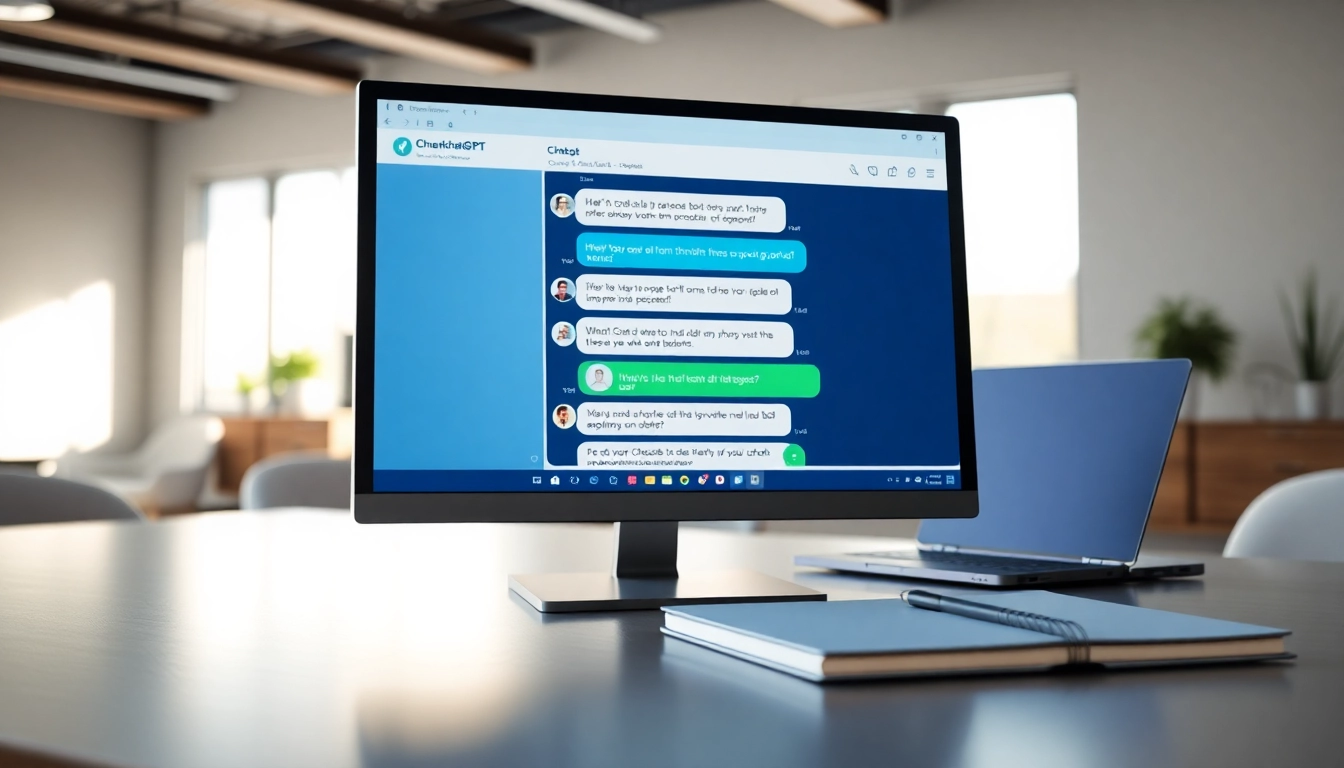Understanding ChatGPT: The Future of Website Interaction
In a world increasingly driven by technology, businesses are constantly looking for efficient ways to enhance user interaction on websites. One noteworthy development in this domain is the chatgpt bot for website, which marries artificial intelligence with user experience. This technology is not merely about automating responses; it transforms the way companies interact with their clients by providing personalized and contextually aware responses. Understanding how ChatGPT works and its benefits can help businesses leverage this innovative tool effectively.
What is a ChatGPT Bot?
ChatGPT bots are advanced conversational agents built using OpenAI’s Generative Pre-trained Transformer (GPT) models. They utilize deep learning techniques to understand and respond to various inquiries in natural language. Unlike traditional chatbots that often rely on scripted interactions, ChatGPT bots excel in generating human-like responses based on the context and nuance of the conversation. This makes them a perfect fit for customer service, FAQs, and personalized marketing on websites.
Core Features of ChatGPT Bots
- Natural Language Understanding: ChatGPT bots can comprehend user inputs in a way that feels intuitive and relatable, allowing for smoother interactions.
- Contextual Awareness: They remember the context of the conversation, enabling them to respond accurately based on previous interactions within the same session.
- Multilingual Capabilities: These bots can understand and respond in multiple languages, broadening the accessibility for global users.
- Customizable Personalities: Businesses can tailor the bot’s tone and style, giving it a unique identity that aligns with the brand.
- Integration with Existing Systems: ChatGPT bots can seamlessly integrate with Customer Relationship Management (CRM) tools, enhancing support efficiency.
Benefits of Integrating ChatGPT into Your Website
Integrating a ChatGPT bot offers numerous advantages to businesses looking to improve customer engagement and satisfaction. Here are some key benefits:
- Enhanced Customer Engagement: A responsive chat interface keeps users engaged, guiding them towards making informed decisions.
- 24/7 Availability: ChatGPT bots can provide around-the-clock support, ensuring that users can get assistance whenever they need it.
- Cost Efficiency: Automating support processes with AI significantly reduces operational costs associated with live customer service.
- Data Collection: ChatGPT bots can collect valuable data on user preferences and behavior, which helps tailor offerings and improve marketing strategies.
- Scalability: These bots can handle an increasing number of inquiries without compromising response quality, making them ideal as businesses grow.
Getting Started with Your ChatGPT Bot Deployment
Once you recognize the potential of a ChatGPT bot, the next step is deployment. Here’s how to approach this process effectively.
Choosing the Right Platform for Implementation
Selecting a suitable platform is crucial for the successful deployment of your ChatGPT bot. Numerous options are available, including:
- Standalone Chatbot Platforms: Solutions like Intercom and Drift provide a complete chat ecosystem.
- API Integration: If you have development capabilities, using APIs from platforms like OpenAI allows for custom integrations tailored to specific needs.
- Website Builders: Many website builders, such as Wix or WordPress, have plugins that support chatbot functionalities directly.
When choosing a platform, consider ease of integration, scalability, and the availability of support and documentation.
Customizing the User Experience with ChatGPT
To maximize user satisfaction, consider customizing the appearance and functionality of your ChatGPT bot. Here are some strategies:
- Branding: Incorporate brand colors and logos to create a familiar appearance.
- Personalized Greetings: Program the bot to greet users specifically based on their past interactions or the pages they visit.
- Tailored Responses: Train the bot with common queries and specialized knowledge about your product or service offerings to ensure relevance.
- Proactive Engagement: Set your bot to initiate conversations based on user behavior, such as time spent on a specific page.
Best Practices for Chatbot Conversations
To enhance the conversation flow and user experience, adhere to these best practices:
- Be Clear and Concise: Ensure that responses from your bot are straightforward, making it easy for users to understand.
- Friendly Tone: Develop a warm, friendly tone that reflects your brand’s personality and encourages engagement.
- Use Quick Replies: Offer pre-defined options for common questions to streamline user interactions.
- Seamless Transition to Humans: If a user’s query goes beyond the bot’s capabilities, ensure there’s an easy way to connect them to a human agent.
Measuring the Success of Your ChatGPT Bot
Implementing a ChatGPT bot is just the first part; measuring its effectiveness is vital for ongoing success and improvement. Here are key considerations for evaluation.
Key Performance Indicators for Chatbots
Track these KPIs to assess the performance of your ChatGPT bot:
- Engagement Rate: Measure how often users interact with the bot compared to total visitors.
- Response Accuracy: Assess how frequently the bot provides correct and satisfactory answers to users’ questions.
- Average Response Time: Evaluate the speed at which users receive responses.
- Conversion Rate: Analyze how many users complete desired actions after interacting with the bot, such as signing up or making a purchase.
- Customer Satisfaction Score (CSAT): Utilize post-interaction surveys to gauge user satisfaction.
Analyzing User Interaction Data
Collecting and analyzing interaction data plays a crucial role in enhancing bot performance. Consider implementing these strategies:
- User Journey Mapping: Visualize likely user paths and identify where the bot excels or falls short.
- Feedback Loops: Regularly collect and review user feedback to identify recurring issues or improvement areas.
- A/B Testing: Experiment with variations in responses and options to determine which performs better with users.
Continuous Improvement Strategies for Your Bot
Once you’ve gathered insights, apply continuous improvement methodologies:
- Regular Updates: Keep the bot’s knowledge base updated with the latest information about your products or services.
- User Training: Provide training sessions for users on how to best engage with the bot.
- Monitor Trends: Stay informed of advancements in AI and chatbot technology to incorporate new features and capabilities.
Common Challenges and Solutions in ChatGPT Implementation
Even with numerous benefits, deploying a ChatGPT bot comes with potential challenges. Here’s how to address them effectively.
Addressing User Misunderstandings
Users may sometimes misinterpret the responses given by the bot due to its AI nature. To mitigate this:
- Clarification Prompts: Implement follow-up questions from the bot to clarify user intents further.
- Feedback Mechanism: Create a system where users can indicate if their questions were understood correctly, helping improve future interactions.
Overcoming Technical Hurdles
Technical challenges could arise, especially during deployment. Address these obstacles with:
- Robust Testing: Perform extensive testing before going live, simulating various user interactions.
- Scalable Infrastructure: Ensure the backend infrastructure can handle user volume without crashes or slowdowns.
Feedback Collection for Enhancements
Gathering user feedback is essential for refining the bot’s capabilities. Use these approaches:
- Post-Interaction Surveys: Short surveys after each session can yield valuable insights regarding user experience.
- Focus Groups: Consider gathering selected users to observe their interactions and solicit in-depth feedback.
Future Trends of Chatbots in Website Development
The chatbot landscape is evolving rapidly, and understanding future trends is crucial for businesses aiming to stay ahead of the curve. Here are some anticipated developments.
AI in Customer Service: What’s Next?
AI technologies will continue to evolve, leading to even smarter and more intuitive chatbots that are equipped to handle complex tasks. Expect features that enable bots to analyze sentiment, predict user needs, and offer personalized advice based on historical interactions.
Integrating Chatbots with Other Tech Innovations
We can anticipate future innovations where chatbots work seamlessly with augmented reality (AR), virtual reality (VR), and voice technology, creating immersive user experiences. This convergence will break down barriers in customer service, providing real-time assistance in various formats.
Preparing for the Future of Automated Conversations
Businesses must adapt to a rapidly changing digital landscape. Investing in continual learning and adaptation of ChatGPT bots ensures they remain relevant. Companies should focus on gathering widespread user data to enhance the conversational AI, ultimately making bots an integral part of customer engagement and satisfaction.



